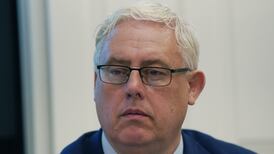GEORGE KIMBALL/America at Large: Ten years ago, just Super Bowl XXVI in Minneapolis, I was summoned to a press briefing by the Native American activist Clyde Bellecourt.
Mr Bellecourt was the founder of the American Indian Movement (AIM), whose headquarters is in the Minnesota city which was staging the 1992 NFL championship game between the Buffalo Bills and the Washington Redskins.
It should hardly come as a shock that progressive-minded Native Americans find the latter nickname offensive. "How would people in Washington like it," Bellecourt asked me that day, "if they named a team 'the Washington Niggers'?"
Most people ignored the AIM's informational pickets at that Super Bowl, but Bellecourt's point was well taken.
Although the ownerships of the Redskins and the Kansas City Chiefs, the Atlanta Braves and the Cleveland Indians, to name a few, resolutely insist the sobriquets are respectful and not derogatory, Indians can probably be forgiven if they don't quite see it that way.
Though the team ownership would have people believe the nickname was intended as a tribute, the evolutionary process went like this: when a Boston team joined the NFL back in the 1930s, it shared both its stadium and its nickname with baseball's Boston Braves.
When the football team relocated to Fenway Park - home to the Red Sox - some years later, it became expeditious to lose the Braves handle, but not the logo, so they readily converted to Redskins. Eventually the Redskins moved to Washington and the Braves first to Milwaukee, then to Atlanta.
IN THEIR present incarnation, the Braves regularly annoy the Native American population. At any given Atlanta home game, half the people in the stands are in possession of $5 foam-rubber tomahawks purchased from the concession stands, which they brandish in unison several times a game as the stadium rocks with a Hollywoodesque version of a tribal war chant.
The Braves are owned by the sportsman-cum-media tycoon Ted Turner, who was married for some time to the actress and prominent political activist Jane Fonda. After Ms Fonda was caught on camera several years ago performing this ritual along with the other Braves fans, she was taken to task by Bellecourt and his followers, who eventually extracted the promise that Jane would never again perform the Tomahawk Chop.
The Cleveland baseball team's mascot, "Chief Nok-a-Homa", is a grotesque caricature of a happily stupid (or, possibly, stupidly happy) Native American.
This is a point to which Irish, or at least Irish-American, people should be particularly sensitive. Possibly the best-known mascot in America is the University of Notre Dame's leprechaun. Intended to depict the school's nickname "The Fighting Irish", the Notre Dame mascot is a pugnacious, green-clad, pipe-smoking little pipsqueak apparently spoiling for a fight with anyone who crosses his path.
Several years ago I chanced to interview the Notre Dame leprechaun, who turned out to be a student of Polish extraction. And this past football season, Notre Dame, in defiance of all logic, had an African-American leprechaun.
And while it might be the most prominent, Notre Dame's isn't even the most offensive leprechaun mascot in the land, as a visit to the Fleet Center for any Boston Celtics home game would quickly attest.
Mike Barnicle, the former Boston Globe columnist, once described "Lucky", the Celtics' mascot, as "nothing more than a cheap shot at Irish-Americans.
"The Celtic mascot looks like someone you might see hanging around the bus station begging for nips," wrote Barnicle. "They might as well have the little jerk throwing up on his shoes or falling down Broadway during the annual St Patrick's parade."
ANYWAY, back to the noble savages. Professional sports franchises have far too much money tied up in team-logoed merchandise to even consider bowing to the objections of Native Americans on this point, but over the past few decades a few of the more progressive colleges have been struck by pangs of conscience. The University of Massachusetts, who were the Redmen when my father played football there 60 years ago, are now the Minutemen. Dartmouth and Stanford, both once called the Indians, have been transformed, respectively, into the Green Wave and The Cardinals.
At high school level, a few states have even enacted legislation to banish the racial stereotypes. In North Carolina, for instance, Indian mascots are supposed to be eliminated from public schools by the end of next year, but that proactive measure represents the exception rather than the rule.
Enter "The Fightin' Whities". For some months the Native American community at the University of Northern Colorado in Greeley had vainly protested the fact that Eaton High School in that town calls its sports teams the "Fighitin' Reds". Rebuffed in their efforts to bring about peaceable change, the Indians went on the warpath and retorted in kind.
Last week an intramural basketball team at the university unveiled its new nickname and mascot. Although all of the Northern Colorado players in question are Native Americans, they have decided to call themselves the Fightin' Whities. Their mascot - presumably available on non-game days for saloon openings, Bar Mitvahs, and St Patrick's Day parades - is a rotund, pasty-faced, middle-aged Caucasian spouting the team motto, "Everythang's gonna be all right!"
"The point is, how does it feel to be made fun of? Let's do something that will let people see the other side of what it's like to be a mascot," explained Solomon Little Owl, the university's director of Native American services who came up with the Fightin' Whities idea.
"I am really offended by this mascot issue, and I hope the people that support the Eaton mascot will be offended by this."










